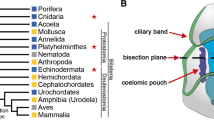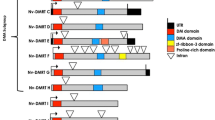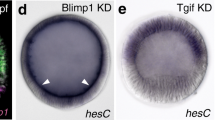Abstract
Due to work in model systems (e.g., flies and mice), the molecular mechanisms of embryogenesis are known in exquisite detail. However, these organisms are incapable of asexual reproduction and possess limited regenerative abilities. Thus, the mechanisms of alternate developmental trajectories and their relation to embryonic mechanisms remain understudied. Because these developmental trajectories are present in a diverse group of animal phyla spanning the metazoan phylogeny, including cnidarians, annelids, and echinoderms, they are likely to have played a major role in animal evolution. The starlet sea anemone Nematostella vectensis, an emerging model system, undergoes larval development, asexual fission, and complete bi-directional regeneration in the field and laboratory. In order to investigate to what extent embryonic patterning mechanisms are utilized during alternate developmental trajectories, we examined expression of developmental regulatory genes during regeneration and fission. When compared to previously reported embryonic expression patterns, we found that all genes displayed some level of expression consistent with embryogenesis. However, five of seven genes investigated also displayed striking differences in gene expression between one or more developmental trajectory. These results demonstrate that alternate developmental trajectories utilize distinct molecular mechanisms upstream of major developmental regulatory genes such as fox, otx, and Hox-like.



Similar content being viewed by others
References
Beck CW, Christen B, Slack JMW (2003) Molecular pathways needed for regeneration of spinal cord and muscle in a vertebrate. Dev Cell 5:429–439
Bely AE, Wray GA (2001) Evolution of regeneration and fission in annelids: insights from engrailed- and orthodenticle-class gene expression. Development 128:2781–2791
Bode HR (2001) The role of hox genes in axial patterning in hydra. Am Zool 41:621–628
Bode HR (2003) Head regeneration in hydra. Dev Dyn 226:225–236
Broun M, Sokol S, Bode HR (1999) Cngsc, a homologue of goosecoid, participates in the patterning of the head, and is expressed in the organizer region of hydra. Development 126:5245–5254
Callaerts P, Munoz-Marmol AM, Glardon S, Castillo E, Sun H, Li WH, Gehring WJ, Salo E (1999) Isolation and expression of a Pax-6 gene in the regenerating and intact planarian Dugesia(G)tigrina. Proc Natl Acad Sci USA 96:558–563
Chourrout D, Delsuc F, Chourrout P, Edvardsen RB, Rentzsch F, Renfer E, Jensen MF, Zhu B, de Jong P, Steele RE, Technau U (2006) Minimal protohox cluster inferred from bilaterian and cnidarian hox complements. Nature 442:684–687
Christen B, Beck CW, Lombardo A, Slack JMW (2003) Regeneration-specific expression pattern of three posterior hox genes. Dev Dyn 226:349–355
Darling JA, Reitzel AR, Burton PM, Mazza ME, Ryan JF, Sullivan JC, Finnerty JR (2005) Rising starlet: the starlet sea anemone, Nematostella vectensis. Bioessays 27:211–221
Duboule D (1994) Guidebook to the homeobox genes. Oxford University Press, New York
Fautin DG (2002) Reproduction of cnidaria. Can J Zool 80:1735–1754
Finnerty JR (2003) The origins of axial patterning in the metazoa: how old is bilateral symmetry. Int J Dev Biol 47:523–529
Finnerty JR, Paulson D, Burton P, Pang K, Martindale MQ (2003) Early evolution of a homeobox gene: the parahox gene gsx in the cnidaria and the bilateria. Evolut Develop 5:331–345
Finnerty JR, Pang K, Burton P, Paulson D, Martindale MQ (2004) Origins of bilateral symmetry: hox and dpp expression in a sea anemone. Science 304:1335–1337
Frank P, Bleakney JS (1976) Histology and sexual reproduction of anemone Nematostella vectensis Stephenson 1935. J Nat Hist 10:441–449
Frank PG, Bleakney JS (1978) Asexual reproduction, diet, and anomalies of anemone Nematostella vectensis in Nova Scotia. Can Field-Nat 92:259–263
Frobius AC, Genikhovich G, Kurn U, Anton-Erxleben F, Bosch TCG (2003) Expression of developmental genes during early embryogenesis of hydra. Dev Genes Evol 213:445–455
Galliot B, Schmid V (2002) Cnidarians as a model system for understanding evolution and regeneration. Int J Dev Biol 46:39–48
Gauchat D, Mazet F, Berney C, Schummer M, Kreger S, Pawlowski J, Galliot B (2000) Evolution of Antp-class genes and differential expression of hydra hox/parahox genes in anterior patterning. Proc Natl Acad Sci USA 97:4493–4498
Genikhovich G, Kurn U, Hemmrich G, Bosch TCG (2006) Discovery of genes expressed in hydra embryogenesis. Dev Biol 289:466–481
Gont LK, Steinbeisser H, Blumberg B, Derobertis EM (1993) Tail formation as a continuation of gastrulation—the multiple cell-populations of the Xenopus tailbud derive from the late blastopore lip. Development 119:991–1004
Hand C, Uhlinger KR (1992) The culture, sexual and asexual reproduction, and growth of the sea anemone Nematostella vectensis. Biol Bull 182:169–176
Hand C, Uhlinger KR (1995) Asexual reproduction by transverse fission and some anomalies in the sea anemone Nematostella vectensis. Invertebr Biol 114:9–18
Handberg-Thorsager M, Salo E (2007) The planarian nanos-like gene smednos is expressed in germline and eye precursor cells during development and regeneration. Dev Genes Evol 217:403–411
Hobmayer B, Rentzsch F, Kuhn K, Happel CM, von Laue CC, Snyder P, Rothbacher U, Holstein TW (2000) Wnt signalling molecules act in axis formation in the diploblastic metazoan hydra. Nature 407:186–189
Lin GF, Chen Y, Slack JMW (2007) Regeneration of neural crest derivatives in the Xenopus tadpole tail. BMC Dev Biol 7:56
Martindale MQ, Pang K, Finnerty JR (2004) Investigating the origins of triploblasty: ‘mesodermal’ gene expression in a diploblastic animal, the sea anemone Nematostella vectensis (phylum, Cnidaria; class, Anthozoa). Development 131:2463–2474
Martinez DE, Dirksen ML, Bode PM, Jamrich M, Steele RE, Bode HR (1997) Budhead, a fork head Hnf-3 homologue, is expressed during axis formation and head specification in hydra. Dev Biol 192:523–536
Masuda-Nakagawa LM, Groger H, Aerne BL, Schmid V (2000) The hox-like gene Cnox2-Pc is expressed at the anterior region in all life cycle stages of the jellyfish Podocoryne carnea. Dev Genes Evol 210:151–156
Mazza ME, Pang K, Martindale MQ, Finnerty JR (2007) Genomic organization, gene structure, and developmental expression of three clustered otx genes in the sea anemone Nematostella vectensis. J Exp Zool B Mol Dev Evol 308B:494–506
Mire P (1998) Evidence for stretch-regulation of fission in a sea anemone. J Exp Zool 282:344–359
Mochizuki K, Sano H, Kobayashi S, Nishimiya-Fujisawa C, Fujisawa T (2000) Expression and evolutionary conservation of nanos-related genes in hydra. Dev Genes Evol 210:591–602
Morgan TH (1901) Regeneration. Macmillan, New York
Orii H, Kato K, Umesono Y, Sakurai T, Agata K, Watanabe K (1999) The planarian hom hox homeobox genes (plox) expressed along the anteroposterior axis. Dev Biol 210:456–468
Reddien PW, Alvarado AS (2004) Fundamentals of planarian regeneration. Annu Rev Cell Dev Biol 20:725–757
Reddien PW, Oviedo NJ, Jennings JR, Jenkin JC, Alvarado AS (2005) Smedwi-2 is a piwi-like protein that regulates planarian stem cells. Science 310:1327–1330
Reinhardt B, Broun M, Blitz IL, Bode HR (2004) Hybmp5–8b, a Bmp5–8 orthologue, acts during axial patterning and tentacle formation in hydra. Dev Biol 267:43–59
Reitzel AM, Burton PM, Krone C, Finnerty JR (2007) Comparison of developmental trajectories in the starlet sea anemone Nematostella vectensis: embryogenesis, regeneration, and two forms of asexual fission. Invertebr Biol 126:99–112
Rossi L, Salvetti A, Lena A, Batistoni R, Deri P, Pugliesi C, Loreti E, Gremigni V (2006) Djpiwi-1, a member of the paz–piwi gene family, defines a subpopulation of planarian stem cells. Dev Genes Evol 216:335–346
Ryan JF, Burton PM, Mazza ME, Kwong GK, Mullikin JC, Finnerty JR (2006) The cnidarian–bilaterian ancestor possessed at least 56 homeoboxes: evidence from the starlet sea anemone, Nematostella vectensis. Genome Biol 7:R64
Salo E (2006) The power of regeneration and the stem-cell kingdom: freshwater planarians (Platyhelminthes). Bioessays 28:546–559
Salo E, Tauler J, Jimenez E, Bayascas JR, Gonzalez-Linares J, Garcia-Fernandez J, Baguna J (2001) Hox and parahox genes in flatworms: characterization and expression. Am Zool 41:652–663
Sanchez-Alvarado A (2006) Planarian regeneration: its end is its beginning. Cell 124:241–245
Shenk MA, Bode HR, Steele RE (1993a) Expression of Cnox-2, a hom hox homeobox gene in hydra, is correlated with axial pattern-formation. Development 117:657–667
Shenk MA, Gee L, Steele RE, Bode HR (1993b) Expression of Cnox-2, a hom/hox gene, is suppressed during head formation in hydra. Dev Biol 160:108–118
Shick J (1991) A functional biology of sea anemones. Chapman and Hall, London
Smith KM, Gee L, Blitz IL, Bode HR (1999) Cnotx, a member of the otx gene family, has a role in cell movement in hydra. Dev Biol 212:392–404
Stocum DL (1995) Wound repair, regeneration and artificial tissues. R G Landes, Austin
Sugiura T, Taniguchi Y, Tazaki A, Ueno N, Watanabe K, Mochii M (2004) Differential gene expression between the embryonic tail bud and regenerating larval tail in Xenopus laevis. Dev Growth Differ 46:97–105
Technau U, Bode HR (1999) Hybra1, a brachyury homologue, acts during head formation in hydra. Development 126:999–1010
Trembley A (1744) Memoires, pour servir à l’histoire d’un genre de polypes d’eau douce, a bras en forme de cornes. Jean and Herman Verbeek, Leiden
Wang YY, Zayas RM, Guo TX, Newmark PA (2007) Nanos function is essential for development and regeneration of planarian germ cells. Proc Natl Acad Sci USA 104:5901–5906
Whitehead GG, Makino S, Lien CL, Keating MT (2005) Fgf20 is essential for initiating zebrafish fin regeneration. Science 310:1957–1960
Yanze N, Spring J, Schmidli C, Schmid V (2001) Conservation of hox/parahox-related genes in the early development of a cnidarian. Dev Biol 236:89–98
Acknowledgements
We would like to thank Mark Martindale and Kevin Pang for their collaborative efforts on embryonic expression in Nematostella. Thanks should also be given to Alexa Bely and James Sikes for critical reading of this manuscript. This research was supported by the National Science Foundation (NSF grant number IBN-0212773).
Author information
Authors and Affiliations
Corresponding author
Additional information
Communicated by M.Q. Martindale
Rights and permissions
About this article
Cite this article
Burton, P.M., Finnerty, J.R. Conserved and novel gene expression between regeneration and asexual fission in Nematostella vectensis . Dev Genes Evol 219, 79–87 (2009). https://doi.org/10.1007/s00427-009-0271-2
Received:
Accepted:
Published:
Issue Date:
DOI: https://doi.org/10.1007/s00427-009-0271-2




